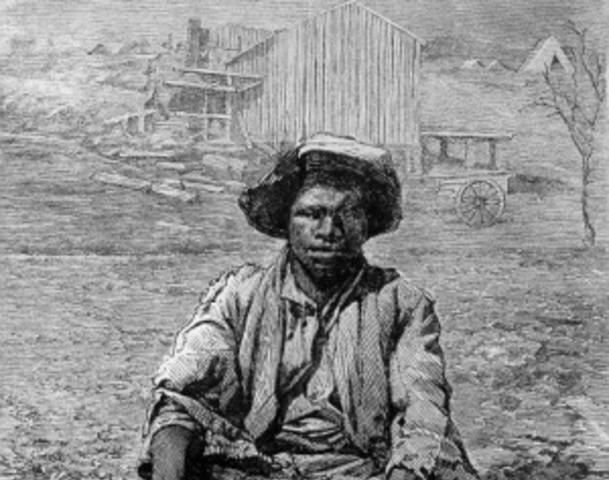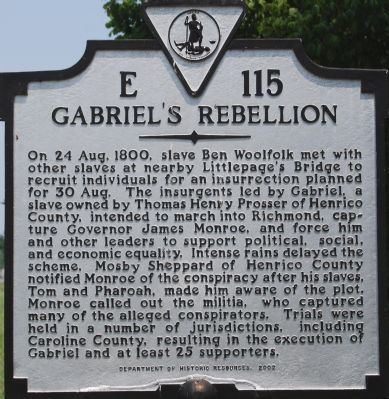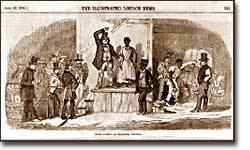Name Gabriel Prosser | Died October 10, 1800 | |
 | ||
Similar William Lloyd Garrison, Nat Turner, Denmark Vesey | ||
Gabriel prosser 1800
Gabriel (1776 – October 10, 1800), today commonly—if incorrectly—known as Gabriel Prosser, was a literate enslaved blacksmith who planned a large slave rebellion in the Richmond area in the summer of 1800. Information regarding the revolt was leaked prior to its execution, and he and twenty-five followers were taken captive and hanged in punishment. In reaction, Virginia and other state legislatures passed restrictions on free blacks, as well as prohibiting the education, assembly, and hiring out of slaves, to restrict their chances to learn and to plan similar rebellions.
Contents
- Gabriel prosser 1800
- Black history month day 3 gabriel prosser
- Life and background
- Gabriels Rebellion
- Historiography
- Influence
- Legacy and honors
- Representation in other media
- Songs
- References

In 2002 the City of Richmond passed a resolution in honor of Gabriel on the 202nd anniversary of the rebellion. In 2007 Governor Tim Kaine gave Gabriel and his followers an informal pardon, in recognition that his cause, "the end of slavery and the furtherance of equality for all people—has prevailed in the light of history".

Black history month day 3 gabriel prosser
Life and background

Born into slavery at Brookfield, a tobacco plantation in Henrico County, Virginia, Gabriel had two brothers, Solomon and Martin. They were all held in bondage by slaveholder Thomas Prosser, the owner of Brookfield. As Gabriel and Solomon were trained as blacksmiths, their father may have had that skill. Gabriel was also taught to read and write.
By the mid-1790s, as Gabriel neared the age of twenty, he stood "six feet two or three inches high". His long and "bony face, well made", was marred by the loss of his two front teeth and "two or three scars on his head". White people as well as Black people regarded the literate young man as "a fellow of great courage and intellect above his rank in life".
Gabriel's Rebellion
Gabriel planned the revolt during the spring and summer of 1800. On August 30, 1800, Gabriel intended to lead slaves into Richmond, but the rebellion was postponed because of rain. The slaves' owners had suspicion of the uprising, and two slaves told their owner, Mosby Sheppard, about the plans. He warned Virginia's Governor, James Monroe, who called out the state militia. Gabriel escaped downriver to Norfolk, but he was spotted and betrayed there by another slave for the reward offered by the state. That slave did not receive the full reward.
Gabriel was returned to Richmond for questioning, but he did not submit. Gabriel, his two brothers, and 23 other slaves were hanged.
Historiography

The historian Douglas Egerton offered a new perspective on Gabriel in his book Gabriel's Rebellion: The Virginia Slave Conspiracies of 1800 & 1802 (1993). He based this on extensive primary research from surviving contemporary documents. Egerton found that Gabriel was a skilled blacksmith who was mostly "hired out" by his owner in Richmond foundries. Hiring out was the way that slaveholders earned money from their slaves, whom they needed less for labor as they had reduced the cultivation of tobacco as a crop. The market for tobacco was depressed, but Virginia planters also had to deal with depleted soils because of the crop. Slaveholders leased skilled slaves for jobs available in Virginia industries. Egerton concluded that Gabriel would have been stimulated and challenged at the foundries by interacting with co-workers of European, African and mixed descent. They hoped Thomas Jefferson's Republicans would liberate them from domination by the wealthy Federalist merchants of the city. In that environment, Gabriel also would have heard about the uprising and struggles of slaves in Saint Domingue.
Egerton believed that Gabriel had two white co-conspirators, at least one of whom was identified as a French national. He found reports that documentary evidence of their identity or involvement was sent to Governor Monroe but never produced in court, and suggests that it was to protect the Jefferson's Democratic-Republican Party. The internal dynamics of Jefferson's and Monroe's party in the 1800 elections were complex. A significant part of the Republican base were major planters, colleagues of Jefferson and Madison. Egerton believes that any sign that white radicals, and particularly Frenchmen, had supported Gabriel's plan could have cost Jefferson the presidential election of 1800. Slaveholders feared such violent excesses as those related to the French Revolution after 1789 and the rebellion of slaves in Saint-Domingue. Egerton believed that Gabriel planned to take Governor Monroe hostage to negotiate an end to slavery. Then he planned to "drink and dine with the merchants of the city".
Egerton noted that Gabriel did not order his followers to kill all whites except Methodists, Quakers and Frenchmen; rather, he instructed them not to kill any people in those three categories. During this period, Methodists and Quakers were active missionaries for manumission, and many slaves had been freed since the end of the Revolution in part due to their work. The French were considered allies as they had abolished slavery in their Caribbean colonies in 1794.
Gabriel initially escaped on a ship owned by a former overseer. Egerton found that he was a recently converted Methodist who repeatedly overlooked information as to Gabriel's true identity. A slave hired out to work on the ship turned in Gabriel, seeking the reward so that he could purchase his own freedom. The state paid him only $50, not the $300 advertised.
Influence
Gabriel's uprising was notable not because of its results—the rebellion was quelled before it could begin—but because of its potential for mass chaos and widespread violence. In Virginia in 1800, 39.2 percent of the total population were slaves; they were concentrated on plantations in the Tidewater area and west of Richmond. No reliable numbers existed regarding slave and free black conspirators; most likely, the number of men actively involved numbered only several hundred.
From 1780 to 1810, the number of slaves freed in the Upper South had grown markedly, as some slaveholders were inspired to free slaves by the American Revolution and its ideals. Methodists and Quakers especially worked to convince slaveholders to manumit slaves. The percentage of free blacks as part of the black population rose from less than 1 percent in 1782 to more than 10 percent by 1810. By that time, Virginia's free blacks numbered 30,466 or 7.2 percent of the total black population. By 1810 nearly three-quarters of Delaware's blacks were free.
Some Virginia slaveholders were nervous about the sharp increase in the number of free blacks in the slave state. They were uneasy as well by the violent aftermath of the French Revolution and the uprising of slaves in the 1790s in Saint Domingue. In 1792 France granted social equality to free people of color, and in 1793 French Revolutionary commissioners in Saint-Domingue granted freedom to all the slaves. Whites and free people of color, some of whom were also slaveholders, emigrated as refugees to the US during the years of upheaval, now known as the Haitian Revolution. They added to the population of free people of color in Charleston, Richmond and New Orleans. In addition, slaveholders brought thousands of ethnic African slaves with them, especially adding to the African population of New Orleans. In 1804 the black and mulatto revolutionaries succeeded in gaining freedom, declaring the colony the independent black nation of Haiti.
Gabriel had been able to plan the rebellion because of relatively lax rules of movement for slaves between plantations and the city, as so many had been hired out, and others traveled to and from the city on errands for their masters. After the rebellion, many slaveholders greatly restricted the slaves' rights of travel when not working. Fears of a slave revolt regularly swept major slaveholding communities.
Prior to the rebellion, Virginia law had allowed education of slaves to read and write, and training of slaves in skilled trades. After the rebellion, and after a second conspiracy was discovered in 1802 among enslaved boatmen along the Appomattox and Roanoke Rivers, the Virginia Assembly in 1808 banned hiring out of slaves and required freed blacks to leave the state within 12 months or face re-enslavement (1806). Free blacks had to petition the legislature to stay in the state, and were often aided in that goal by white friends or allies. In addition to the catalyst of Gabriel's Rebellion, the law against residency was prompted by the marked increase in population of free people of color in Virginia, as noted above in manumission of slaves after the American Revolution. The very existence of free blacks challenged the conditions of slave states.
Legacy and honors
Gabriel's rebellion served as an important example of slaves' taking action to gain freedom.
